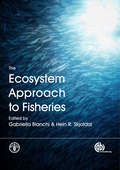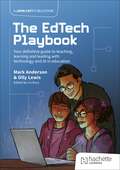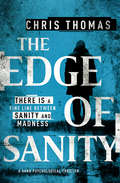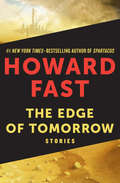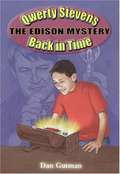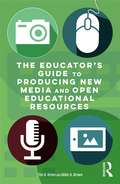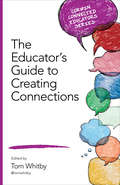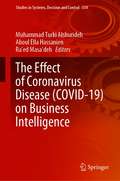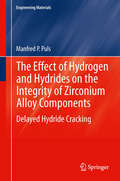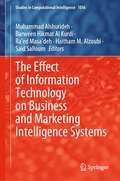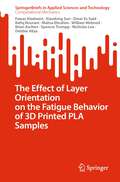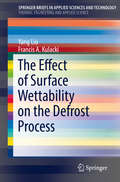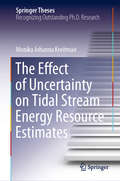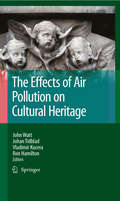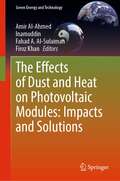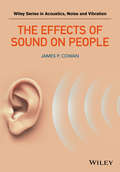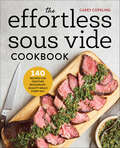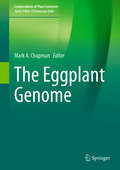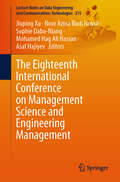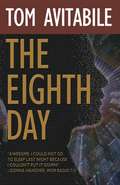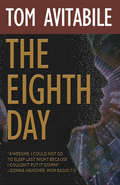- Table View
- List View
The Ecosystem Approach to Fisheries
by Hein Rune Skjoldal Gabriella BianchiThe ecosystem approach to fisheries management is high on national, regional and international agendas for sustainable fisheries management. Implementing the Ecosystem Approach to Fisheries covers both theoretical and applied aspects, with a particular emphasis on practical experiences in the form of case studies from around the world, and tools for solutions. Researchers, practitioners and policy makers in fisheries, aquaculture, marine biology and ecology will find this book an invaluable overview and guide to fisheries management.
The EdTech Playbook: Your Definitive Guide to Teaching, Learning and Leading with Technology and AI in Education
by Mark Anderson Olly LewisThe EdTech Playbook is your go-to guide to using EdTech in evidence-informed ways to help you work smarter, transform your teaching and enrich students' learning.Whether you're an experienced educator or newly qualified, this book is packed with practical strategies and real-life examples from fellow teachers you can benefit from. Learn about:- expert advice from experienced authors who know what works- powerful case studies showcasing how educators at all levels use technology to make a difference- time-saving tips to reclaim your precious time- how to leverage AI to support your teaching and their learning- workable ideas to bring light into your everyday teaching practice- how to support digital transformation at scale- the importance of online safety and the role of safeguarding and data privacy in EdTech.The EdTech Playbook is your roadmap to increasing not just your knowledge and skills, but also your creativity in how you apply technology in the classroom. Dive in and become the tech-savvy educator you've always dreamed of being!
The EdTech Playbook: Your Definitive Guide to Teaching, Learning and Leading with Technology and AI in Education
by Mark Anderson Olly LewisThe EdTech Playbook is your go-to guide to using EdTech in evidence-informed ways to help you work smarter, transform your teaching and enrich students' learning.Whether you're an experienced educator or newly qualified, this book is packed with practical strategies and real-life examples from fellow teachers you can benefit from. Learn about:- expert advice from experienced authors who know what works- powerful case studies showcasing how educators at all levels use technology to make a difference- time-saving tips to reclaim your precious time- how to leverage AI to support your teaching and their learning- workable ideas to bring light into your everyday teaching practice- how to support digital transformation at scale- the importance of online safety and the role of safeguarding and data privacy in EdTech.The EdTech Playbook is your roadmap to increasing not just your knowledge and skills, but also your creativity in how you apply technology in the classroom. Dive in and become the tech-savvy educator you've always dreamed of being!
The Edge of Sanity: A Dark Psychological Thriller
by Chris ThomasA new drug will give you your best—and last—high in this “amazing follow up to Enter the Dark . . . Fast-paced, gruesome and very dark” (The Book Magnet).In a derelict squat, the Smart Man watches as the new narcotic developed by his shadowy organisation wreaks havoc on its unsuspecting victims. The drug is now ready for sale on their exclusive darknet marketplace.Meanwhile, former detective Pete Harris had started a new life away from the Cyber Crimes Unit with his daughter and begins to rekindle his relationship with a former colleague. Unknown to Pete, the retired head of the unit has sought out crime boss Curtis Slater and offered him information—for a price.With his life seemingly complete, Pete’s world comes crashing down as he is drawn into Slater’s game with fatal consequences. He must join forces with his old enemies in a race against time. But can Pete save his loved ones from the clutches of Slater, the Smart Man . . . and a sinister ringmaster?“An action-packed story! Interesting plot threads cleverly woven together, with plenty to keep the reader turning the pages.” —Bibliophile Book Club
The Edge of Tomorrow: A Novel
by Howard FastScience fiction stories from the #1 New York Times–bestselling author of Spartacus. From one of the most prolific and versatile writers of the twentieth century, The Edge of Tomorrow is a collection of tales that journey outside everyday boundaries to offer insight into our own universe. Featuring big bugs, cloned cats, and feral star-children, these unconventional, thought-provoking stories reveal much about the America of their time, when the Cold War and the nascent civil rights movement stoked unconscious fears and desires. From &“The First Men,&” about scientists tampering with genetic engineering, to &“The Large Ant,&” about a man&’s thoughtless violence against nature, these stories by the author of April Morning and The Immigrants—described by the Los Angeles Times as &“one of our very best&”—are as relevant today as when they were first written. This ebook features an illustrated biography of Howard Fast including rare photos from the author&’s estate.
The Edison Mystery
by Dan GutmanThirteen-year-old Robert "Qwerty" Stevens uses the time machine he finds in his backyard to visit Thomas Edison's workshop in 1879, and there helps develop the electric light bulb, but then needs his sister's help to return to his own time.
The Educator's Guide to Producing New Media and Open Educational Resources
by Abbie H. Brown Tim D. GreenDigital video, audio, and text have never been more popular, and educators need to know how to make new media work in all types of learning environments. The Educator’s Guide to Producing New Media and Open Educational Resources provides practical advice on how to produce and use open access resources to support student learning. This realistic "how-to" guide is written for education professionals in any discipline seeking to transform their instruction with technology.
The Educator′s Guide to Creating Connections (Corwin Connected Educators Series)
by Tom WhitbyBlogging, social media, and PLN’s made easy! Collectively, we’re all smarter than we are individually. In this expert guide, EdTech leaders help you harness the power of connected collaboration using the Internet and social media. You’ll easily leverage Twitter, Facebook, LinkedIn and beyond for profound professional growth. Use real-world tips and tools to: Master and adapt to 21st Century teaching methodologies Build ongoing technology literacy for you and your students Connect and collaborate with education leaders across the globe Get connected. Get engaged. Use this inspiring, step-by-step manual to expand your personal and professional network today! The Corwin Connected Educators series is your key to unlocking the greatest resource available to all educators: other educators. Being a Connected Educator is more than a set of actions: it’s a belief in the potential of technology to fuel lifelong learning. "The successful educator is a connected educator. Quite simply, this book is a manual to stay relevant and energized in a rapidly changing profession. I highly recommend this as the definitive guidebook on building connections for the modern educator." Vicki Davis, Author "Reinventing Writing" Tom Whitby has brought together a who′s who list any educator would want to be connected with and learn from! His latest book shares great ideas on how teachers can use online strategies as one way to look and learn beyond our all-too-often isolated classrooms. Larry Ferlazzo, Award-Winning Teacher, Blogger, and Author Helping Students Motivate Themselves
The Educator′s Guide to Creating Connections (Corwin Connected Educators Series)
by Tom WhitbyBlogging, social media, and PLN’s made easy! Collectively, we’re all smarter than we are individually. In this expert guide, EdTech leaders help you harness the power of connected collaboration using the Internet and social media. You’ll easily leverage Twitter, Facebook, LinkedIn and beyond for profound professional growth. Use real-world tips and tools to: Master and adapt to 21st Century teaching methodologies Build ongoing technology literacy for you and your students Connect and collaborate with education leaders across the globe Get connected. Get engaged. Use this inspiring, step-by-step manual to expand your personal and professional network today! The Corwin Connected Educators series is your key to unlocking the greatest resource available to all educators: other educators. Being a Connected Educator is more than a set of actions: it’s a belief in the potential of technology to fuel lifelong learning. "The successful educator is a connected educator. Quite simply, this book is a manual to stay relevant and energized in a rapidly changing profession. I highly recommend this as the definitive guidebook on building connections for the modern educator." Vicki Davis, Author "Reinventing Writing" Tom Whitby has brought together a who′s who list any educator would want to be connected with and learn from! His latest book shares great ideas on how teachers can use online strategies as one way to look and learn beyond our all-too-often isolated classrooms. Larry Ferlazzo, Award-Winning Teacher, Blogger, and Author Helping Students Motivate Themselves
The Effect of Coronavirus Disease (Studies in Systems, Decision and Control #334)
by Aboul Ella Hassanien Muhammad Turki Alshurideh Ra’ed Masa’dehThis book includes recent research works on how business around the world affected by the time of COVID-19 pandemic. The impact of recent technological developments has had a tremendous impact on how we manage disasters. These developments have changed how countries and governments collect information. The COVID-19 pandemic has forced online service companies to maintain and build relationships with consumers when their world turns. Businesses are now facing tension between generating sales during a period of severe economic hardship and respect for threats to life and livelihoods that have changed consumer preferences.
The Effect of Hydrogen and Hydrides on the Integrity of Zirconium Alloy Components
by Manfred P. PulsBy drawing together the current theoretical and experimental understanding of the phenomena of delayed hydride cracking (DHC) in zirconium alloys, The Effect of Hydrogen and Hydrides on the Integrity of Zirconium Alloy Components: Delayed Hydride Cracking provides a detailed explanation focusing on the properties of hydrogen and hydrides in these alloys. Whilst the emphasis lies on zirconium alloys, the combination of both the empirical and mechanistic approaches creates a solid understanding that can also be applied to other hydride forming metals. This up-to-date reference focuses on documented research surrounding DHC, including current methodologies for design and assessment of the results of periodic in-service inspections of pressure tubes in nuclear reactors. Emphasis is placed on showing how our understanding of DHC is supported by progress in general understanding of such broad fields as the study of hysteresis associated with first order phase transformations, phase relationships in coherent crystalline metallic solids, the physics of point and line defects, diffusion of substitutional and interstitial atoms in crystalline solids, and continuum fracture and solid mechanics. Furthermore, an account of current methodologies is given illustrating how such understanding of hydrogen, hydrides and DHC in zirconium alloys underpins these methodologies for assessments of real life cases in the Canadian nuclear industry. The all-encompassing approach makes The Effect of Hydrogen and Hydrides on the Integrity of Zirconium Alloy Component: Delayed Hydride Cracking an ideal reference source for students, researchers and industry professionals alike.
The Effect of Information Technology on Business and Marketing Intelligence Systems (Studies in Computational Intelligence #1056)
by Ra’ed Masa’deh Muhammad Alshurideh Barween Hikmat Al Kurdi Haitham M. Alzoubi Said SalloumBusiness shapes have been changed these days. Change is the main dominant fact that change the way of business operations running. Topics such as innovation, entrepreneurship, leadership, blockchain, mobile business, social media, e-learning, machine learning, and artificial intelligence become essential to be considered by each institution within the technology era. This book tries to give additional views on how technologies influence business and marketing operations for insuring successful institutions survival.The world needs to develop management and intelligent business scenario plans that suite a variety of crisis appears these days. Also, business and marketing intelligence should meet government priorities in individual countries and minimise the risk of business disruptions. Business intelligence - the strategies and technology companies that use it to collect, interpret, and benefit from data - play a key role in informing company strategies, functions, and efficiency. However, being essential to the success, many companies are not taking advantage of tools that can improve their business intelligence efforts. Information technology become a core stone in business. For example, the combination of machine learning and business intelligence can have a far-reaching impact on the insights the company gets from its available data to improve productivity, quality, customer service and more. This book is important because it introduces a large number of chapters that discussed the implications of different Information technology applications in business. This book contains a set of volumes which are: 1- Social Marketing and Social Media Applications, 2- Social Marketing and Social Media Applications, 3- Business and Data Analytics, 4- Corporate governance and performance, 5- Innovation, Entrepreneurship and leadership, 6- Knowledge management, 7- Machine learning, IOT, BIG DATA, Block Chain and AI, 8- Marketing Mix, Services and Branding.
The Effect of Layer Orientation on the Fatigue Behavior of 3D Printed PLA Samples (SpringerBriefs in Applied Sciences and Technology)
by Rafiq Noorani Fawaz Aladwani Xiaodong Sun Omar Es-Said Mahsa Ebrahim William Melmed Brian Avchen Spencer Trumpp Nicholas Lee Debbie AliyaThis book presents fused deposition modeling (FDM) which is an additive manufacturing (AM) process to fabricate 3D parts from a build-up of 2D layers. The chapters present an experimental analysis of fatigue characteristics of FDM-processed PLA samples. The results indicate that the concentric build orientation provides highest cycles of fatigue, ultimate strength, and impact energy. The effect of layer orientation on the fatigue behavior of 3D-printed PLA samples is investigated in this case study.
The Effect of Surface Wettability on the Defrost Process (SpringerBriefs in Applied Sciences and Technology)
by Francis A. Kulacki Yang LiuThis SpringerBrief presents a recent advancement in modeling and measurement of the effect of surface wettability on the defrost process. Carefully controlled laboratory measurements of the defrosting of cooled surfaces are used to reveal the effect of surface wetting properties on the extent and speed of frost removal by melting or slumping. The experiments are accompanied by visualization of frost removal at several defrosting conditions. Analysis breaks the defrost process into three stages according to the behavior of the meltwater. Surface wetting factors are included, and become significant when sufficient meltwater accumulates between the saturated frost layer and the surface. The book is aimed at researchers, practicing engineers and graduate students.
The Effect of Uncertainty on Tidal Stream Energy Resource Estimates (Springer Theses)
by Monika Johanna KreitmairThis thesis is focused on river and tidal stream power assessment, focussing particularly on uncertainties in power estimates resulting from inaccurate characterisation of bed roughness and turbine drag. It presents analytical and numerical models for the transfer of these uncertainties through to turbine power uncertainty in a strait, exploring how this affects metrics such as mean power and its standard deviation. Perturbation methods are used to determine the leading-order effects of friction and drag uncertainty in tidal stream power assessment.The methods for uncertainty transfer presented in this thesis could readily be applied to numerous other problems encountered in hydraulic engineering, such as flow routing, urban flood risk, and reservoir sedimentation. It will therefore be of interest to researchers, engineers, and students in these fields.
The Effects of Air Pollution on Cultural Heritage
by Ron Hamilton John Watt Johan Tidblad Vladimir KuceraThis book reviews the sources of the air pollutants responsible for building damage and the mechanisms involved. Studies investigating the relationships between pollution concentration (dose) and the resulting damage (response) are described and the latest research findings for dose-response functions are presented. Trends in pollutant emissions, ambient concentrations and building damage over time are described and future predictions are presented. Methodologies for assessing the extent of the potential problem in a region - the stock at risk - are presented. Procedures for estimating the economic implications are described and the consequences are discussed in detail, because economic factors are important for reaching policy and management decisions at local, national and international scales. Damage to cultural heritage buildings is an important additional effect which needs to be considered as the standards are revised and the factors which will need to be brought into the assessment are presented.
The Effects of Dust and Heat on Photovoltaic Modules: Impacts and Solutions (Green Energy and Technology)
by Inamuddin Firoz Khan Amir Al-Ahmed Fahad A. Al-SulaimanThis book discusses how to reduce the impact of dust and heat on photovoltaic systems. It presents the problems caused by both dust accumulation and heat on PV systems, as well as the solutions, in a collected piece of literature. The Effects of Dust and Heat on Photovoltaic Modules: Impacts and Solutions begins by discussing the properties of dust accumulation on PV modules. It then presents several solutions to this, such as hydrophobic coatings and surface texturing. The second half of the book is used to discuss the effects of heat on silicon PV modules, as well as various cooling approaches. These include water cooling and carbon-based materials. Due to the prevalence of PV systems in renewable energy, this book will be of interest to numerous students, researchers and practitioners.
The Effects of Sound on People
by James P. CowanProvides a summary of current research results on the physiological and psychological effects of sound on people Covers how the operation of the hearing mechanism affects our reactions to sounds Includes research results from studies on noise sources of public concern such as transportation, public utility, and recreational sources, with emphasis on low frequency sound and infrasound Covers sounds that affect some but not others, how sounds can be controlled on a practical level, and how and what sounds are regulated Includes coverage of both positive and negative effects of sound
The Effects of Traffic Structure on Application and Network Performance
by Kevin Jeffay Jay Aikat F. Donelson SmithOver the past three decades, the Internet's rapid growth has spurred the development of new applications in mobile computing, digital music, online video, gaming and social networks. These applications rely heavily upon various underlying network protocols and mechanisms to enable, maintain and enhance their Internet functionality The Effects of Traffic Structure on Application and Network Performance provides the necessary tools for maximizing the network efficiency of any Internet application, and presents ground-breaking research that will influence how these applications are built in the future. The book outlines how to design and run all types of networking experiments, and establishes the best practices in synthetic traffic generation for current and future researchers and practitioners to follow. It addresses some basic concepts and methods of traffic generation, but also details extensive empirical research in testing and evaluating network protocols and applications within a laboratory setting. The Effects of Traffic Structure on Application and Network Performance is designed as a reference book for networking professionals who must design, plan, test and evaluate their networks. Advanced-level students and researchers in computer science and engineering will find this book valuable as well
The Effortless Sous Vide Cookbook: 140 Recipes for Crafting Restaurant-Quality Meals Every Day
by Carey CopelingThe Effortless Sous Vide Cookbook serves easy, everyday recipes for restaurant-quality mealsIt's easy to make perfectly cooked food with your sous vide, but finding the right recipes to do it night after night can be tricky. The Effortless Sous Vide Cookbook serves well-rounded, restaurant-quality meals for easy, everyday cooking. Featuring 140 no-fuss recipes, plus an overview of basic practices and new sous vide cooking techniques, The Effortless Sous Vide Cookbook transforms every kitchen into a Michelin-star restaurant.The Effortless Sous Vide Cookbook includes:Over 140 Weeknight Recipes for making vegetables, fish and seafood, red meat, poultry, dessert, and even drinks!Sous Vide 101 covering the basic sous vide practices along with new techniquesQuick Reference Guides featuring helpful charts to help you gage timing, temperature, and power to your modelSous vide cookbook recipes include: Vegetable Halloumi Kebabs, Seared Wasabi Ahi Tuna, Rosemary Veal Chop, Peanut Chicken Satay, Duck Confit, Salted Caramel Cheesecake, Espresso Martini, and much more!Make perfectly cooked meals a staple at your table with The Effortless Sous Vide Cookbook.
The Egg and I
by Betty MacdonaldThis is the first book, which Betty MacDonald wrote. It chronicles her real-life adventures with her first husband--a man who built a good barn long before fixing the rundown house. Other books by Betty MacDonald are available from Bookshare.
The Eggplant Genome (Compendium of Plant Genomes)
by Mark A. ChapmanThe book discusses the importance of eggplant (Solanum melongena L.) as a crop, highlighting the potential for eggplant to serve as a model for understanding several evolutionary and taxonomic questions. It also explores the genomic make-up, in particular in comparison to other Solanaceous crops, and examines the parallels between eggplant and tomato domestication as well as between the most common eggplant species and two related eggplants native to Africa (Ethiopian eggplant [Solanum aethiopicum L.] and African eggplant [Solanum macrocarpon L.]).The eggplant genome was first sequenced in 2014, and an improved version was due to be released in 2017. Further investigations have revealed the relationships between wild species, domesticated eggplant, and feral weedy eggplant (derived from the domesticate), as well as targets of selection during domestication. Parallels between eggplant and tomato domestication loci are well known and the molecular basis is currently being investigated.Eggplant is a source of nutrition for millions of people worldwide, especially in Southeast Asia where it is a staple food source. Domesticated in the old world, in contrast to its congeners tomato and potato, the eggplant is morphologically and nutritionally diverse. The spread of wild eggplants from Africa is particularly interesting from a cultural point of view. This book brings together diverse fields of research, from bioinformatics to taxonomy to nutrition to allow readers to fully understand eggplant’s importance and potential.
The Eighteenth International Conference on Management Science and Engineering Management (Lecture Notes on Data Engineering and Communications Technologies #215)
by Jiuping Xu Asaf Hajiyev Sophie Dabo-Niang Mohamed Hag Ali Hassan Noor Azina Binti IsmailThe proceedings of the Eighteenth ICMSEM cover a wide range of areas including hot management issues in Engineering Science. It provides newest and frontier ideas and research achievements in the area of Management Science and Engineering Management to researchers and practitioners. The work contains both theoretical and practical studies of Management Science in the Computing Methodology, showing the advanced management concepts, computing technologies for decision making problems with large, uncertain and unstructured data. Research in this proceeding will show the new changes and challenges in the decision-making procedure as we have entered the big data era. Theoretical studies of this proceedings will present the new technologies of analysis, capture, search, sharing, storage, transfer, visualization, and privacy violations, as well as advances in integration of optimization, statistics and data mining. This proceeding also contains practical studies in the real decision-making scenarios when facing large, uncertain or unstructured data. The readers who are interested in related fields of can benefit from the proceedings for the new ideas and research direction.
The Eighth Day
by Tom AvitabileA chemical engineer sets in motion a horrendous explosion killing hundreds of commuters and himself.Hollywood's hottest sex symbol assassinates a sitting senator.A grandmother stages a sophisticated attack on a train causing massive damage.An airplane full of Silicon Valley's brightest is blown up while refueling.A series of deadly, unrelated events or the unlikely start of an insidious new terror network?As Science Advisor to the President, William "Wild Bill" Hiccock is tasked with assembling a team to identify and stop the threat, whether homegrown or foreign. His team - a retired Navy admiral, a wise-guy computer hacker sprung from federal prison, and his ex-wife, a leading behavioral psychologist - must identify and destroy their elusive adversary who always seems to be a step ahead.
The Eighth Day: Quarterback Operations Group Book 1 (Quarterback Operations Group #1)
by Tom AvitabileIn this action-packed political thriller, a motley crew is assembled to aid the US government in deciphering what&’s causing a series of bizarre attacks before it&’s too late. A chemical engineer sets in motion a horrendous explosion killing hundreds of commuters and himself. Hollywood&’s hottest sex symbol assassinates a sitting senator. A grandmother stages a sophisticated attack on a train causing massive damage. An airplane full of Silicon Valley&’s brightest is blown up while refueling. A series of deadly, unrelated events, or the unlikely start of an insidious new terror network? As science advisor to the president, William &“Wild Bill&” Hiccock is tasked with assembling a team to identify and stop the threat, whether homegrown or foreign. His team—a retired Navy admiral, a wise-guy computer hacker sprung from federal prison, and his ex-wife, a leading behavioral psychologist—must identify and destroy their elusive adversary who always seems to be one step ahead. &“Awesome. I could not go to sleep last night because I couldn&’t put it down.&” —Donna Hanover, WOR Radio 710 &“Frighteningly realistic. Most of Washington really works this way. Homeland Security had better read this one and take corrective action.&” —Michael Skol, US Ambassador &“The author weaves a tale that will occasionally take your breath away and then cause you to sigh with relief . . . He is a master wordsmith who knows the value of just the right phrase at just the right moment. His timing will keep you on the edge of your chair.&” —Bill Twomey, CNG Newspaper Group &“A thriller with some insights into human behavior.&” —Mel Robbins, CNBC
